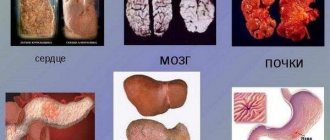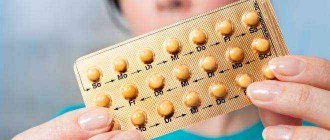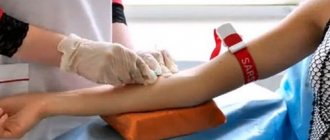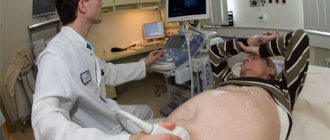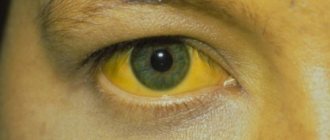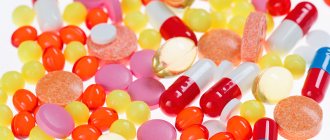What does an enlarged liver mean?
An enlarged liver is not a disease, but a symptom of some problem related to the functioning of the liver. In medicine, this phenomenon is called hepatomegaly and means that the liver ceases to perform its functions. Hepatomegaly, if left untreated, can lead to the development of a fatal disease - liver failure. A routine medical examination is sufficient to detect liver enlargement.
To identify the causes, more thorough research and analysis will be required:
- Ultrasound or tomography to accurately determine the size of the liver and assess the general condition.
- MRI will accurately show the condition of the bile ducts.
- Blood tests. Necessary for examining liver enzymes, the presence of viral infections and other disorders.
- Biopsy. This test is prescribed if cancer or fatty disease is suspected.
Diagnosis of the disease
If signs of an enlarged liver are detected, you need to visit a therapist for an initial examination. He will identify the cause of the disorder, associated diseases, and refer the patient to the appropriate doctor: cardiologist, gastroenterologist, oncologist, endocrinologist, hepatologist.
During the initial examination, palpation is indicated. A specialist can easily detect a greatly enlarged liver by touch. Pay attention to consistency. So, with obesity it is loose, with cirrhosis it is hard.
Diagnosis and identification of the cause of the pathology occurs using one or more methods:
- Blood test, incl. biochemical: to assess liver enzymes, identify infections, inflammatory processes;
- Analysis of urine;
- Stool testing: to assess the digestive ability and enzymatic activity of the stomach, pancreas, the occurrence of inflammation in the intestines;
- Tests for hepatitis;
- Biopsy;
- Ultrasound;
- X-ray;
- MRI;
- CT scan.
This is interesting: Hepatomegaly: what is it and how to treat liver enlargement with folk remedies?
Diagnostic measures are adjusted according to symptoms. An ultrasound is mandatory, as it shows the condition and size of the lobes and veins. Normally the indicators are:
- Length: 14-20 cm. In this case, the right lobe is up to 11-15 cm, the left lobe is 10 cm, with a thickness of up to 6 cm;
- Sagittal size: 9-12 cm;
- Cross section: 20-22.5 cm.
Causes of liver enlargement
- Liver diseases:
- Fatty hepatosis (large number of fat cells in the liver).
- Cholestatic hepatosis (impaired bile outflow)
- Hepatitis
- Viral or bacterial infections
- Cirrhosis
- Hereditary diseases associated with metabolic disorders
- Diseases associated with circulatory disorders:
- Heart failure
- Blockage of the hepatic veins
- Exchange disorders:
- Hemochromatosis
- Fat metabolism disorders
- The appearance of neoplasms:
- Cysts
- Benign tumors
- Cancerous tumors
- Exposure to toxins:
- Alcohol damage
- Drug damage
- Cholelithiasis
- Helminth damage
Symptoms of liver enlargement
Liver enlargement can be determined independently when the following symptoms appear:
- Feeling of discomfort in the right hypochondrium, feeling of heaviness
- Dyspeptic disorders - nausea, heartburn, changes in stool, belching, accompanied by an unpleasant odor.
- Change in skin color - yellowness, characteristic of hepatomegaly.
- Changes in behavior – nervousness, irritability, drowsiness or insomnia.
Since the above signs may indicate other disorders in the functioning of the body, for an accurate diagnosis it is necessary to consult a specialist. There is no need to delay your visit to the doctor - timely measures will help avoid serious consequences.
Survey
The list of diagnostic procedures for newly detected liver enlargement is compiled depending on the complaints, concomitant symptoms and medical history.
Below is an indicative list of examinations and tests:
- general blood analysis
- biochemical blood test - total protein, albumin, glucose
- liver tests - bilirubin, ALT, AST, GGT, alkaline phosphatase
- tests for viral hepatitis, cytomegalovirus, Epstein-Barr virus
- blood clotting
- tumor markers - AFP, CEA, CA 19-9
- lipid profile - total cholesterol, triglycerides, low-density lipoproteins
- thyroid hormones
- ferritin, ceruloplasmin
- blood culture
- echocardiography (ultrasound of the heart) to evaluate the function of the left ventricle of the heart
- CT and MRI
- ERCP
- liver biopsy - primarily for diagnosing congenital metabolic diseases
Enlarged liver in a child
In infants, liver enlargement may be associated with neonatal jaundice. It does not require treatment as it goes away within a month. The causes of this condition may be birth injuries, diabetes and other disorders of the endocrine system in the mother.
In a child under 7 years of age, hepatomegaly is a completely normal physiological phenomenon. It is considered normal if the baby’s liver protrudes slightly beyond the edges of the ribs (by 1–2 cm). As the child grows, the liver becomes normal in size. In any case, the doctor will most accurately determine whether the child needs treatment.
In children, liver enlargement may indicate the following diseases:
- Inflammatory processes in the body.
- Congenital TORCH infections
- Liver damage from toxins or drugs.
- Metabolic pathology
- Disorders of the biliary tract, blockage of the bile ducts
- Metastases or tumors
A cause for concern is an enlarged liver in children in combination with other “danger signals”: fever, venous network in the abdomen, vomiting, skin rashes, weight loss, loss of appetite, yellowness of the mucous membranes. When these signs appear, the pediatrician prescribes a consultation with a hepatologist, infectious disease specialist, or gastroenterologist. To identify the exact cause of liver enlargement, a number of tests and ultrasound examination are necessary.
How the liver changes as the child grows
The size of a healthy liver changes with age. After birth, children's liver sizes are normally quite large. The normal weight is about 4–5% of the total body weight. At the same time, boys have slightly larger livers than girls. The organ almost completely covers the stomach, filling the epigastric region.
- The size of the left lobe of the fetal liver is especially large, and its lower edge is located in the navel area.
- The weight of the gland may vary slightly among different children, but on average it is about 150 g. The lower edge of the gland in a newborn in the midline protrudes from under the costal arch by 35–40 mm, and the upper edge is located in the area of the 5th or 6th rib along the axillary line.
- Up to 3 years of age, iron increases in its parameters relatively slowly, but, nevertheless, a doubling of its size is observed annually.
- A sharp growth of the organ occurs during puberty, when the weight of the gland reaches 1.3 kg.
Diet for liver enlargement
A properly organized diet will help the liver cope with hepatomegaly. The diet for liver enlargement excludes spicy, salty, fatty foods. The diet must contain proteins, vitamins, minerals and fiber. You need to eat more fish, vegetables, fruits, taking into account their calorie content.
The most useful foods: apples, avocados, dried apricots, turkey, turmeric, green tea, herbs.
Food should enter the body in small portions so as not to overload the diseased liver. Small meals are recommended (6–7 times a day) for better digestion. Read more about what you can and cannot eat if you have liver disease.
Sample menu for a week with an enlarged liver
Monday.
Meal 1 – Milk rice porridge without adding butter and sugar, green tea with honey or rosehip decoction.
Meal 2 – Boiled river fish
Meal 3 – Boiled carrots, grated
Meal 4 – Steamed vegetable dish (without salt and spices)
Meal 5 – Fresh fruit
Tuesday
Meal 1 – Omelet from one egg (without yolk), rosehip decoction or green tea
Meal 2 – Dried fruits (dried apricots, prunes, raisins), previously poured with boiling water.
Meal 3 – Veal or chicken broth, bran bread
Meal 4 – Low-fat cottage cheese
Meal 5 – Salad of greens and cucumbers
Wednesday
Meal 1 – Low-fat kefir or cottage cheese
Method 2 – Rosehip decoction with honey
Method 3 – Steamed meatballs
Meal 4 – Pumpkin puree, herbal tea
Meal 5 – Baked cheesecakes with dried fruits
Thursday
Meal 1 – Oatmeal with milk, green tea with honey and lemon
Meal 2 – Compote with dried fruits
Meal 3 – Steamed river fish, bran bread
Meal 4 – Vegetable casserole, bran bread
Meal 5 – Herbal tea
Friday
Meal 1 – Boiled pasta in small quantities
Meal 2 – Dietary buckwheat soup, bran bread
Meal 3 – Dried fruits soaked in boiling water
Meal 4 – Milk porridge
Meal 5 – Green tea with honey
Saturday
Meal 1 – Buckwheat porridge cooked in water without salt and sugar, herbal tea
Meal 2 – Fruit platter
Meal 3 – Veal or chicken broth, bran bread
Meal 4 – Sauerkraut salad
Meal 5 – Pastila or fruit marmalade
Sunday
Meal 1 – Cheese pancakes with dried fruits, cooked in the oven, green tea with honey and lemon
Meal 2 – Veal or turkey, boiled and pureed with the addition of boiled carrots or pumpkin
Meal 3 – Rosehip decoction, bran bread
Meal 4 – Kefir or cottage cheese
Meal 5 – Fruit or vegetable salad
It is also necessary to maintain equal periods of time between meals. Any diet must be discussed with a doctor, who will give all the necessary recommendations. With an enlarged liver, nutrition should be optimally balanced. Therefore, it is periodically necessary to adjust and diversify the diet. Alcohol, coffee, chocolate, confectionery, salt, pepper, vinegar are the main enemies of the liver. For any liver disease, legumes in any form, nuts, and carbonated drinks are contraindicated.
On the subject: The best folk recipes and products that restore liver cells
Treatment of liver enlargement
If the examination does not reveal any diseases, and the liver is enlarged, then changing your lifestyle will help quickly return the liver to normal. Most often, to restore normal size, you need to get rid of excess weight and give up bad habits. It is necessary to completely change the daily routine and reconsider nutrition. At the slightest hint of liver enlargement, it is better to immediately give up alcohol and smoking, limit the consumption of spicy, salty and fatty foods. Proper distribution of physical activity, sufficient time for sleep and rest, walks and exercise - all this will help restore normal liver function.
Treatment of an enlarged liver in any case should be carried out under strict medical supervision. Modern treatment methods include long-term use of medications and homeopathic medications, diet, and limitation of physical activity.
Nutrition and diet
What to do
what
if the liver is enlarged
? First of all, you need to reconsider your eating habits. The quality of the diet directly affects liver function and human health in general. Therefore, adherence to a diet is an integral requirement not only during the period of treatment of the syndrome, but throughout the patient’s entire subsequent life. To do this, it is recommended to adhere to the following recommendations.
- Eat often, in small portions - up to 6 times a day.
— The average interval between meals is 3–4 hours.
— Dinner – no later than 19.00.
— Eliminate fatty, fried, smoked, canned, sweet, salty, hot and spicy foods from your diet. As well as food products with chemical additives - dyes, thickeners, preservatives, etc.
— Reduce the consumption of fats and carbohydrates – no more than 50 g and 70 g, respectively.
— Refuse animal fats in favor of vegetable fats.
— The preferred methods of heat treatment of products are boiling, baking, steaming.
- As a rule, patients with the syndrome are prescribed diet No. 5 according to Pevzner. Allowed foods include vegetables, fruits, dairy products, lean fish, low-fat poultry, cereals, dried fruits, and vegetable oils.
The general rule for a diseased liver is that the amount of meat in different forms should be reduced. But the exact answer to the recommended amount of protein in individual cases: in case of cirrhosis or hepatitis, should be given by a specialist after he sees the result of a biochemical analysis.
What to add to your diet? Definitely everyone - plant fibers, natural vitamins and minerals with antioxidant properties and amino acids from plant protein. This problem can be solved with the help of the NutriDetox green smoothie.
